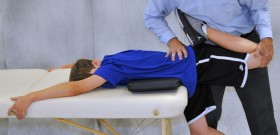
Facilitated stretching
Slow, Static Stretch – “3-S”:
Hold each static stretch for a minimum of 30 seconds (it takes at least 20 seconds to overcome the bias from the protective stretch reflex) and repeat each stretch a minimum of two times. More significant gains in flexibility will be made if the stretches are held for 40 seconds to 2 minutes or longer and repeated 3-4 times.
Stretch the tightest areas first. Be progressive in your stretching. Exhale as you stretch further into the range and then breathe normally as the stretch is held at the point of tightness.
NB: This type of stretching should be organized in a separate routine from training and is used to increase soft tissue length. Caution must be used when doing this type of stretching prior to hard training as it may weaken the muscle and leave it prone to injury. Instead use a “facilitated” or “dynamic” stretch.
“Facilitated Stretch”: Hold Relax & Contract Relax:
Facilitated stretches make use of the “inverse myotatic reflex”, where nerve receptors in the tendon are sensitive to isometric contraction and relax the muscle when it occurs. Two methods may be used: i) contract – relax: tighten the same (agonist) muscle, then stretch it ii) hold – relax: tighten the opposite (antagonist) muscle, then stretch it
Use a partner you can trust who takes the muscle slowly to the point of tightness, applies appropriate resistance (approx. 25-30%) for 6-8 seconds then assists you to stretch further into the range. Many traditional static stretches can also become facilitated stretches by using a towel, wall or your hands to apply resistance. This type of stretching will help increase range of motion and strengthen the muscle.
“Dynamic Flexibility:/b>
Utilizes controlled combined joint movements to push the limits of optimal range of motion prior to activities that are dynamic in nature. Examples of this are shoulder and arm swings, hip and leg swings, lunges, squats and torso twists.
A dynamic warm-up helps normalize joint mechanics, increases the dynamic ROM, improves joint position sensors (proprioception), and improves the “relaxation contraction” coordination. This type of stretching is appropriate prior to beginning any activity and must be included as part of the warm-up.
“Ballistic”
This is a fast stretch that increases flexibility through a series of bouncing movements that violently try to lengthen the muscle group. This type of stretching should be approached with extreme caution and limited to high-level athletes under the direction of a strength and conditioning specialist as the stretch reflex will cause increased tightness of the muscle to protect it.
This type of stretching is not suitable for recreational athletes. Instead stick with the static, facilitated and dynamic stretches.
Read similar stories in our section Stretching.